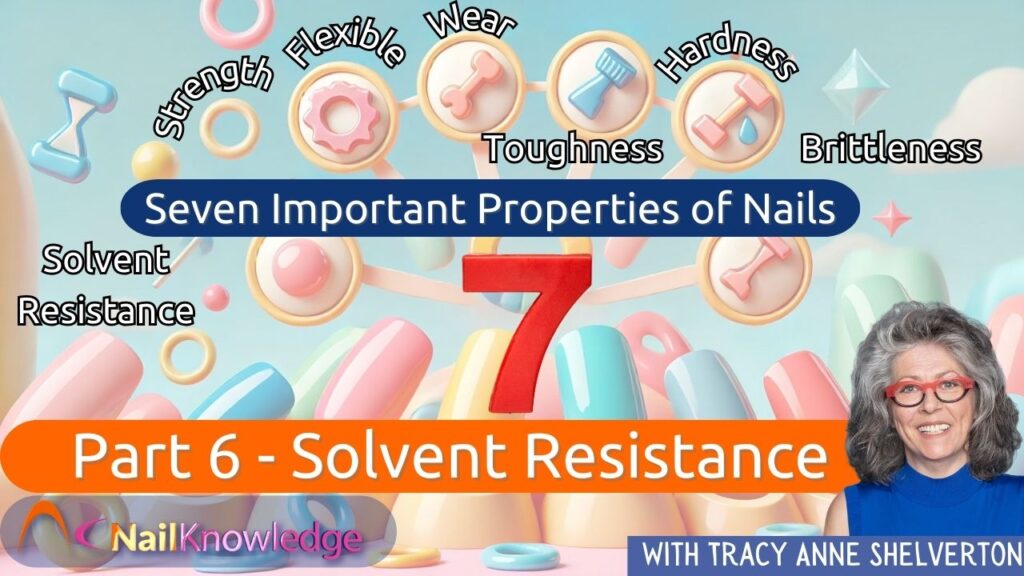In this sixth part of our series on the key properties of natural and artificial nails, we’ll explore solvent resistance. As we’ve already discussed properties like strength, hardness, flexibility, toughness, and brittleness, solvent resistance is another critical factor that helps maintain the health and longevity of both natural and artificial nails. Solvents are liquids that dissolve solids or other liquids, and in nail care, it is important to understand how different solvents interact with nails, especially with artificial coatings.
What Is Solvent Resistance and Why Is It Important?
Solvent resistance refers to a material’s ability to withstand the effects of liquids, such as water or acetone, without breaking down or dissolving. Water is known as the “Universal Solvent” because it dissolves more substances than any other liquid, but it doesn’t dissolve natural or artificial nails. Both types of nails are resistant to water, which is crucial since regular exposure to water would otherwise cause damage over time.
While natural nails can absorb small amounts of water and other solvents, they do not dissolve in them. This solvent resistance ensures that natural nails remain intact even when exposed to moisture. Artificial nails, however, are typically more resistant to water absorption, yet can be affected by other solvents like acetone, which is commonly used to remove nail polish and artificial coatings.
Nail Hardness and Solvent Resistance
Nail hardness plays a significant role in determining a nail’s resistance to solvents. Artificial nail coatings, such as acrylics and UV gels, vary in their resistance to solvents based on their formulation. For example, methyl methacrylate (MMA) and certain UV-curable gels are highly resistant to solvents like acetone, making them more challenging to remove. These coatings can take an hour or more to dissolve in acetone, indicating high solvent resistance. However, this same resistance to acetone can also prevent the penetration of nail oils, which are essential for maintaining flexibility.
In contrast, some artificial nail coatings are formulated to break down more easily in acetone, making removal quicker. These coatings tend to absorb nail oils more effectively, allowing them to maintain the necessary balance of flexibility and strength. The more solvent-resistant a coating is, the more likely it will resist both acetone and nail oils, which can impact the flexibility of the nails.
The Role of Acetone in Solvent Resistance
Acetone is one of the most common solvents used in nail care, primarily for the removal of artificial nail coatings. It is fast-acting, penetrating most artificial nails within ten to twenty minutes. However, the time it takes for acetone to break down a coating can vary widely based on the type of artificial nail product used.The resistance of artificial nails coatings to acetone also provides insight into their ability to absorb other substances like nail oils. Nail coatings that take longer to break down in acetone are often less likely to absorb nail oils, which can reduce the flexibility of the nails over time. When applying nail maintenance, it’s important to realise that applying oil behind the free edge essential is to prevent unnecessary brittleness of the natural nail under the nail coating. On the other hand, coatings that dissolve more easily in acetone are typically better at absorbing oils, which can help increase the nail’s flexibility and prevent brittleness.
How to Address Nail Brittleness with Nail Oils
When natural or artificial nails become brittle, restoring flexibility is key, and nail oils are highly effective in achieving this. These oils penetrate the nail plate and help restore flexibility by balancing out strength and hardness. Nail oils can penetrate most artificial nail coatings. To improve penetration, warming the nail oil to slightly above body temperature (around 100°F or 38°C) can significantly speed up absorption for all nail coating users but especially for those with brittle nails.
Natural nails, despite their resistance to solvents like acetone, have built-in channels that allow for the transmission of natural oils from the nail bed to the nail plate. These oils, which include substances like squalene, help maintain nail flexibility. While some believe that nails can’t contain oils because they lack sebaceous glands, this is just not true. The underlying tissues of the nail bed produce oils including squaline, contributing to the overall health and flexibility of the nail plate and the nail unit.
Maximizing Solvent Resistance for Optimal Nail Health
Maintaining solvent resistance in artificial nails is essential for ensuring their longevity and performance. However, this resistance must be balanced with the ability to absorb nail oils, as overly rigid nail coatings can lead to brittleness. For natural nails, minimalizing water absorption and maintaining natural oil content helps preserve flexibility and prevents cracking.
In conclusion, solvent resistance is an important property of both natural and artificial nails, protecting them from damage caused by liquids like water and acetone. Understanding how this resistance interacts with other key properties, such as nail hardness and flexibility, allows nail care professionals to make informed choices about the products, maintenance products and treatments they use.
Explore More Key Properties of Nails in Our 7-Part Series:
- Nail Strength – Discover how the strength of nails impacts their performance and durability.
- Nail Hardness – Understand the crucial role of hardness in nail health and how to maintain the perfect balance.
- Nail Flexibility – Understand the importance of flexibility in preventing nail breakage and maintaining resilience.
- Nail Toughness – Find out what makes nails tough and how this property differs from strength and hardness.
- Nail Brittleness – Learn what causes brittleness in nails and how to prevent it.
- Nail Solvent Resistance – Explore how nails can resist damage from chemicals and solvents.
- Nail Wear – Understand the factors that affect how well nails withstand regular use and environmental exposure.
By understanding solvent resistance and its connection to nail hardness and flexibility, you’ll gain insights into how to maintain both natural and artificial nails for long-term health and durability not only of the nail coatings but also the nail unit – allowing for continued and regular use of your favourite nail coatings without the need for a break in use due to excessive dryness or nail plate damage (see blog about nail plate etching and or passive nail plate prep).


